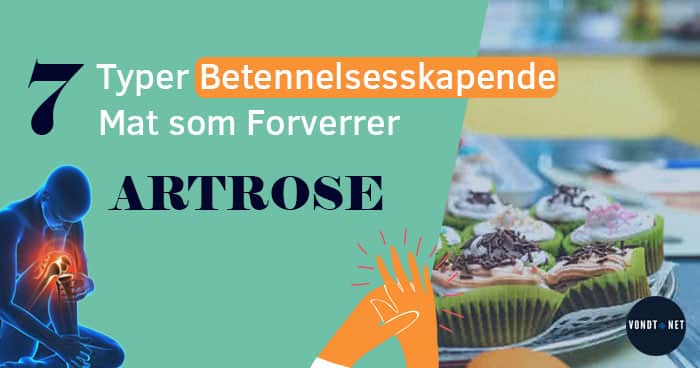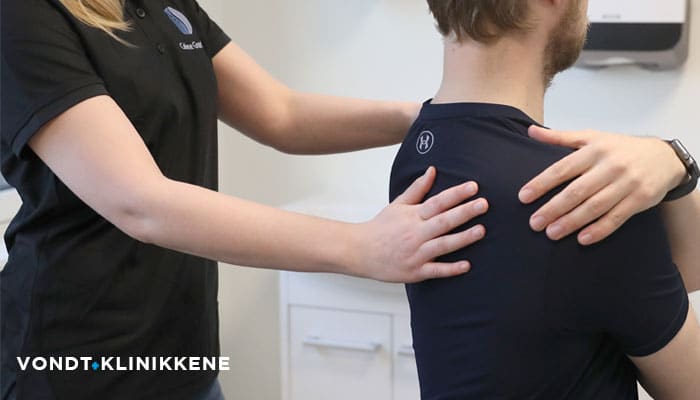7 types of inflammatory foods that aggravate osteoarthritis
Last updated 29/02/2024 by The pain clinics - Interdisciplinary Health
7 types of inflammatory foods that aggravate osteoarthritis
Certain types of food can cause osteoarthritis (osteoarthritis). In this article, we go through 7 types of inflammatory foods that can cause more joint pain and arthritis (arthritis). Diet is an important part of preventing and reducing joint disease - and this article can give you useful and good information on what you should avoid to avoid flare-ups.
Arthritis means inflammation of the joints which helps to break down shock-absorbing cartilage - and which thus leads to osteoarthritis. There are a number of rheumatic joint diseases, among others rheumatic arthritis, which leads to extensive joint destruction and deformity of joints (for example, crooked and bent fingers or toes - such as in osteoarthritis of the hands). For the latter (RA), we recommend daily use of specially adapted compression gloves og compression socks for rheumatologists (opens in new link).
- A better everyday life for people with rheumatism and those with chronic pain
We fight for those with other chronic pain diagnoses and rheumatism to have better opportunities for treatment and investigation. So we kindly ask you to like us on our FB page og our YouTube channel in social media to join us in the fight for an improved everyday life for thousands of people.
This article will cover seven types of inflammatory foods - seven ingredients you should avoid if you have osteoarthritis and arthritis. At the bottom of the article, you can also read comments from other readers, as well as see recommended self-measures and a video with exercises adapted to those with osteoarthritis.
1. Sugar

Foods with a high sugar content – such as baked goods (for example school bread and pastry), cookies and candy - can actually change how your immune system works. Indeed, research has shown that the pro-inflammatory response when eating too much sugar can actually cause your immune system to be manipulated to help microbes and pathogens (1). Yes, that's right- sugar and pro-inflammatory ingredients actually make you sick.
This reaction called "Glyco-Evasion-Hypothesis" thus helps to aggravate inflammation in your body and joints. To sum up, this is because your immune system is tricked into not attacking the microbes, pathogens and "the other bad guys" - but rather helps to help them spread further inflammation and inflammation.
The result is a powerful pro-inflammatory process that contributes to fluid retention and inflammatory reactions in the bone tissue and joints. Over time, this can cause the joint to become damaged and both cartilage and other bone tissue break down. We recommend the use of honey or pure maple syrup as natural substitutes for sugar.
We remind you that one of the best ways to prevent joint wear is by strengthening nearby stability muscles. Such prevention is primarily about strengthening the muscles that relieve the joints. For example, training the thighs, seat and hips can be a very good way to relieve both hip and knee arthritis (2). The video below shows examples of good hip osteoarthritis exercises.
VIDEO: 7 Exercises against Osteoarthritis in the Hip (Click below to start the video)
Feel free to subscribe for free on our channel - and follow our page at FB for daily, free health tips and exercise programs that can help you toward even better health.
2. Salt

Eating too much salt can cause the cells in the body to start to swell because they start to hold too much water. That said, salt minerals are essential for your body to function - but what we're talking about here is what happens when you get too much of it.
The Arthritis Foundation refers to figures that conclude that one should not eat more than 1.5 grams of salt a day. To put this into perspective, people generally eat 3.4 grams each day according to research. So well over twice as much as the recommended dosage.
This causes inflammatory reactions in our cells and joints - with associated fluid accumulation - which in turn results in an increased incidence of joint pain and arthritis.
3. Fry with

Fried foods are often fried in pro-inflammatory oil and contain a high content of saturated fat, as well as preservatives. Some of the most common examples of such foods are donuts and french fries. Due to the combination of the content and how these foods are made, these are known to be extremely inflammatory - that is, they contribute to increased and stronger inflammatory reactions in your body.
We are not saying that it is not allowed to enjoy yourself at times, but the problem lies in being part of your daily diet. If you are suffering from severe arthritis diseases, such as rheumatic arthritis, then it is extra important to stick to a strict diet and avoid the unnecessary temptations.
The "fibromyalgia diet" is a good example of a collection of anti-inflammatory dietary rules and tips. We recommend that you read through the article below if you suffer from osteoarthritis, arthritis, fibromyalgia or other chronic pain syndromes.
Also read: - Research report: This is the Best Fibromyalgia Diet
4. White flour

Processed wheat products, such as white bread, stimulate the body's inflammatory reactions. This is why those with osteoarthritis and arthritis should preferably avoid eating too much pasta, cereal and cereal. Many also report that they experience significant improvement in their joint pain and joint inflammation by cutting out gluten.
White flour and processed grain products thus contribute to more inflammation of the joints and increased joint pain. So if you eat a lot of such food products and at the same time suffer from osteoarthritis, then you should cut or cut it out of your diet.
5. Omega-6 Fatty Acids

Research has shown that having too much omega 6 fatty acids in your diet can increase your risk of cardiovascular disease, cancer, inflammation and autoimmune diagnoses. It has been seen that an uneven relationship between omega 3 fatty acids (anti-inflammatory) and omega 6 can cause problems and increased joint inflammation for those with osteoarthritis and arthritis.
Especially found with omega 6 fatty acids in traditional unhealthy foods such as junk food, cakes, snacks, potato chips and stored meat (such as salami and cured ham). This means that a person with arthritis should avoid this type of food - and rather focus on foods that have a high content of omega 3 (such as oily fish and nuts).
Ginger can be recommended for anyone who suffers from rheumatic joint ailments - and it is also known that this root has one a host of other positive health benefits. This is because ginger has a strong anti-inflammatory effect. Many people with osteoarthritis drink ginger as a tea - and then preferably up to 3 times a day during periods when the inflammation in the joints is extremely strong. You can find some different recipes for this in the link below.
Also read: - 8 Incredible Health Benefits Of Eating Ginger
6. Milk products

Dairy products cause inflammatory reactions in some people - which in turn provides a basis for increased joint pain and arthritis. A 2017 research study (3) showed that many people with arthritis can have a marked decrease in symptoms and pain by cutting out cow's milk.
It has also been seen that switching to almond milk can be a good alternative. Because then you still get healthy fats and important nutrients.
7. alcohol

Alcohol, and especially beer, has a very high content of purines. Purines are probably known to many as a precursor to uric acid in the body which, among other things, provides the basis gout, but it also generally contributes to increased inflammation of your body and joints.
Bored for those who are very fond of beer. But if you want less joint inflammation and pain, then you have to cut back on the alcohol. That's just how it is.
Recommended self-measures for arthrosis, arthritis and joint pain
Many of our patients ask us about self-measures that can alleviate their osteoarthritis and joint pain. Here, our advice and recommendations will be adapted to which areas are affected by osteoarthritis. If it is, for example, osteoarthritis in the neck that causes tight nerve conditions, we would recommend daily use of neck hammock to relieve the muscles and joints of the neck - and reduce the risk of pinching.
We therefore divide our recommendations into four categories:
- Hand and finger arthrosis
- Foot osteoarthritis
- Knee osteoarthritis
- Neck osteoarthritis
1. Self-measures against osteoarthritis in hands and fingers
Hand arthritis can give rise to reduced grip strength and stiff fingers. For osteoarthritis in the fingers and hands, we are happy to recommend compression gloves, as these also have a documented effect in that they provide better hand function in osteoarthritis. In addition to this, we also recommend training your grip strength custom hand trainers (the links open in a new browser window).
Tips for hand osteoarthritis: Compression gloves
Click on the image or link here to read more about these gloves. Many people with arthrosis and arthritis report a good effect when using these.
2. Self-measures against osteoarthritis in the feet and toes
Osteoarthritis in the foot can cause joint pain and stiffness. It can also lead to joint changes in the toes which can give rise to more pronounced hallux valgus (crooked big toe). When our patients ask for good recommendations for this type of osteoarthritis, we happily recommend daily use of foot massage roller, toe spreaders og compression socks (the links open in a new browser window).
Tips for foot osteoarthritis: Compression socks
Said the compression socks provides good compression and support around the sole of the foot and the heel region. One of the main purposes of compression socks is to increase blood circulation to muscles, tendons and joints. The increased circulation then in turn provides increased access to nutrients for use in healing and repair mechanisms. Click on the image or link above to read more about how they work.
3. Self-measures against knee osteoarthritis
Joint wear and arthritis in the knees can take a toll on everyday life. Naturally enough, such ailments can lead to you walking less and being less mobile due to pain. For this type of joint pain, we have two main recommendations - in the form of knee compression support og arnica salve (the links open in a new browser window). The latter can be massaged into sore joints and provide pain relief.
Tips against knee osteoarthritis: Arnica ointment (massaged into the knee joint)
Many people with arthrosis and arthritis in the knees, and other joints, report a positive and soothing effect when using arnica ointment. It is used by massaging the ointment into the joint that is painful. Click on the image or link here to read more about how it works.
4. Self-measures against neck osteoarthritis
We mentioned earlier that osteoarthritis and calcifications in the neck can give rise to cramped conditions for the nerves. This in turn can lead to increased pain and muscle tension. One of our main recommendations for those suffering from neck osteoarthritis is the use of neck berth (also known as neck hammock). It works by stretching the joints slightly apart, and provides relief to both muscles and nerves. Research has shown that as little as 10 minutes of daily use has documented a relieving effect against neck pain. In addition to this, we are also happy to recommend heat salve - to dissolve tight neck muscles.
Tips for neck osteoarthritis: Neck hammock (for decompression and relaxation)
There is little doubt that our necks are subjected to a lot of stress in our modern age. Increased use of, among other things, PCs and mobile phones led to more static load and compression on the muscles and joints of the neck. The neck hammock gives your neck a well-deserved break - and can also show in research how as little as 10 minutes of daily use resulted in less neck pain and reduced nerve pressure. Press the image or here to read more about this smart self-measure.
Pain clinics: Feel free to contact us if you have any questions
We offer modern assessment, treatment and rehabilitation training for pain in muscles, tendons, joints and nerves. Several of our clinicians have "active with osteoarthritis" certification.
Feel free to contact us via one of our clinic departments (the clinic overview opens in a new window) or on vår Facebook-side (Vondtklinikkenne - Health and Training) if you have any questions. For appointment booking, we have XNUMX-hour online booking at the various clinics so that you can find the consultation time that suits you best. You are of course also welcome to call us during the clinics' opening hours. We have interdisciplinary departments in, among other places, Oslo (incl Lambert seats) and Viken (Raw wood og Eidsvoll). Our skilled therapists look forward to hearing from you.
More information about osteoarthritis and joint pain? Join this group!
Join the Facebook group «Rheumatism and Chronic Pain - Norway: Research and news»(Click here) for the latest updates on research and media writing about rheumatic and chronic disorders. Here, members can also get help and support - at all times of the day - through the exchange of their own experiences and advice.
Feel free to share in social media
Again, we would like to kindly ask you to share this article on social media or via your blog (please link directly to the article). Understanding and increased focus is the first step towards a better everyday life for those with rheumatism and chronic pain.
Sources:
PubMed [links are directly listed in the article]











Knowledge is great. Soon I will see an article that contains what diet one should have. Almost without exception there is unfortunately NO and SHOULD NOT.